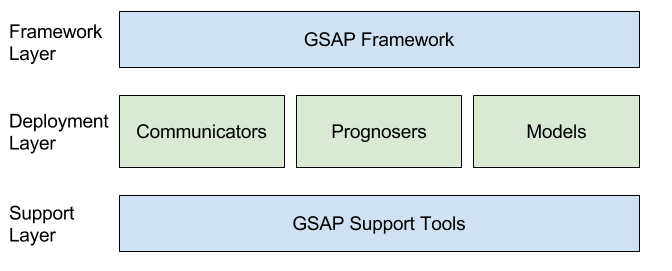The Generic Software Architecture for Prognostics (GSAP) is a framework for applying prognostics. It makes applying prognostics easier by implementing many of the common elements across prognostic applications. The standard interface enables reuse of prognostic algorithms and models across using the GSAP framework.
There are two operational modes for GSAP: 'async' and 'simple'. These are both described below:
- 'async': Asynchronous GSAP. This takes advantage of parallization, including automatic thread management to perform calculations on multiple threads.
- 'simple': Simple single-threaded GSAP. Resulting prognostics application is smaller and simplier, but does not take advantage of multi-threading. Ideal for resource constrained hardware.
The GSAP framework is used through the creation of communicators, prognosers, or models (the deployment layer). The elements of the deployment layer plugs into the framework and use the tools of the support layer. These elements are described further below:
- Communicators:
Communicators are used to communicate data with the outside world. These function as interfaces with various data sources and sinks. Some examples could be a playback agent that reads from a file, a GUI for displaying prognostic results, an automated report generator, or a client that connects into a network messaging system (for example: SCADA). These systems can receive data which will be used by prognosers or communicate the results with operators.
-
Prognosers:
This is the core of the GSAP system. Inside the prognosers is the core logic for performing prognostics. A new prognoser is created to support a new method for performing prognostics. Many prognostics systems follow a common model-based structure. Those systems do not require the creation of a new prognoser, only the creation of a new model that will be used by the modelBasedPrognoser. For more information on this see the section Extending.
-
Models:
Models are a method of representing the behavior of a component. A common way of performing prognostics is using a model that describes both the healthy and damaged behavior of the components. The modelBasedPrognoser uses the models to perform prognostics.
Each of these components is configured through the use of configuration files. This allows for a GSAP deployment to be configured to a new configuration or system without any software changes.
See the Getting Started page for information
GSAP is designed to be easy to extend to fit your use. Extending GSAP is done by adding Prognosers, Models, Algorithms, or Communicators. When the behavior of the component being prognosed is represented by a model, users can create a new model and use the supplied modelBasedPrognoser for prognostics. This is done instead of adding a new prognoser. For more information on extending see the wiki here
If you have questions, please contact Chris Teubert (christopher.a.teubert@nasa.gov)
All contributions are welcome! If you are having problems with the plugin, please open an issue on GitHub or email Chris Teubert. If you would like to contribute directly, please feel free to open a pull request against the "develop" branch. Pull requests will be evaluated and integrated into the next official release.
Copyright ©2016, 2019 United States Government as represented by the Administrator of the National Aeronautics and Space Administration. All Rights Reserved.
No Warranty: THE SUBJECT SOFTWARE IS PROVIDED "AS IS" WITHOUT ANY WARRANTY OF ANY KIND, EITHER EXPRESSED, IMPLIED, OR STATUTORY, INCLUDING, BUT NOT LIMITED TO, ANY WARRANTY THAT THE SUBJECT SOFTWARE WILL CONFORM TO SPECIFICATIONS, ANY IMPLIED WARRANTIES OF MERCHANTABILITY, FITNESS FOR A PARTICULAR PURPOSE, OR FREEDOM FROM INFRINGEMENT, ANY WARRANTY THAT THE SUBJECT SOFTWARE WILL BE ERROR FREE, OR ANY WARRANTY THAT DOCUMENTATION, IF PROVIDED, WILL CONFORM TO THE SUBJECT SOFTWARE. THIS AGREEMENT DOES NOT, IN ANY MANNER, CONSTITUTE AN ENDORSEMENT BY GOVERNMENT AGENCY OR ANY PRIOR RECIPIENT OF ANY RESULTS, RESULTING DESIGNS, HARDWARE, SOFTWARE PRODUCTS OR ANY OTHER APPLICATIONS RESULTING FROM USE OF THE SUBJECT SOFTWARE. FURTHER, GOVERNMENT AGENCY DISCLAIMS ALL WARRANTIES AND LIABILITIES REGARDING THIRD-PARTY SOFTWARE, IF PRESENT IN THE ORIGINAL SOFTWARE, AND DISTRIBUTES IT "AS IS."
Waiver and Indemnity: RECIPIENT AGREES TO WAIVE ANY AND ALL CLAIMS AGAINST THE UNITED STATES GOVERNMENT, ITS CONTRACTORS AND SUBCONTRACTORS, AS WELL AS ANY PRIOR RECIPIENT. IF RECIPIENT'S USE OF THE SUBJECT SOFTWARE RESULTS IN ANY LIABILITIES, DEMANDS, DAMAGES, EXPENSES OR LOSSES ARISING FROM SUCH USE, INCLUDING ANY DAMAGES FROM PRODUCTS BASED ON, OR RESULTING FROM, RECIPIENT'S USE OF THE SUBJECT SOFTWARE, RECIPIENT SHALL INDEMNIFY AND HOLD HARMLESS THE UNITED STATES GOVERNMENT, ITS CONTRACTORS AND SUBCONTRACTORS, AS WELL AS ANY PRIOR RECIPIENT, TO THE EXTENT PERMITTED BY LAW. RECIPIENT'S SOLE REMEDY FOR ANY SUCH MATTER SHALL BE THE IMMEDIATE, UNILATERAL TERMINATION OF THIS AGREEMENT.
